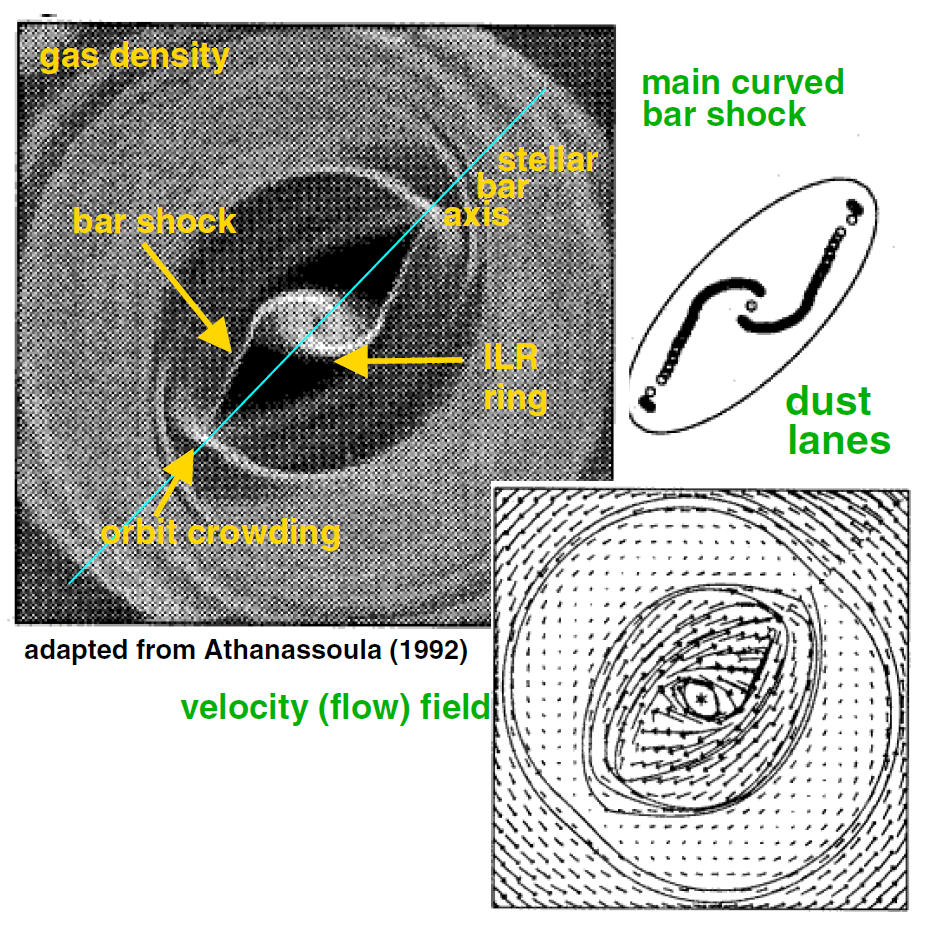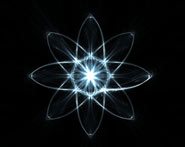


 الفيزياء الكلاسيكية
الفيزياء الكلاسيكية
 الكهربائية والمغناطيسية
الكهربائية والمغناطيسية
 علم البصريات
علم البصريات
 الفيزياء الحديثة
الفيزياء الحديثة
 النظرية النسبية
النظرية النسبية
 الفيزياء النووية
الفيزياء النووية
 فيزياء الحالة الصلبة
فيزياء الحالة الصلبة
 الليزر
الليزر
 علم الفلك
علم الفلك
 المجموعة الشمسية
المجموعة الشمسية
 الطاقة البديلة
الطاقة البديلة
 الفيزياء والعلوم الأخرى
الفيزياء والعلوم الأخرى
 مواضيع عامة في الفيزياء
مواضيع عامة في الفيزياء|
Read More
Date: 10-2-2017
Date: 16-12-2015
Date: 14-12-2015
|
Gas flows and infall: Feeding the nuclear region
A bar provides an obvious mechanism to redistribute angular momentum and to funnel material toward the center of a galaxy. This results in the expectation that gas will flow along the bar and thus become available to feed central activity, a circumnuclear starburst or, possibly, a central black hole. Since the bar is, therefore, intimately connected to the degree of activity we can expect from the Galactic black hole, we will briefly examine the processes that lead to the inflow.
The structure of a bar is governed by the location of its characteristic resonances. The most important of those are the corotation resonance (CR, mentioned earlier), where ΩP = Ω, i.e. the angular velocity of circular rotation Ω is identical to the bar pattern speed ΩP, and the Inner Lindblad Resonance(s) (ILR), with the criterion ΩP = Ω-κ/2 (κ is the epicycle frequency the epicycle frequency is related to the periodic motion of stars at a given location in the disk compared to their motion relative to a reference frame moving at a constant circular velocity). While there is always one CR, there may be zero, one or two ILRs, depending on the details of the bar potential and the degree of central mass concentration. Within a bar potential, a number of orbit types can be distinguished (e.g. Binney and Tremaine 1987, Contopoulos and Grosbol 1989). The orbits change the orientation of their major axis by 90o at each resonance.
Gas has to settle on orbits that are stable in the sense of being nonintersecting. Otherwise, the clouds, being viscous, suffer collisions that will result in a quick dissipation of angular momentum and orbital energy, and move them to stable orbits deeper within the potential well of the bar. Thus, for gas clouds we can restrict ourselves to considering two orbit types: x1-orbits, which are elongated along the bar axis, occur between the ILR and the CR and sustain the bar; and x2-orbits, which are more circular, but elongated perpendicular to the bar major axis and occur within the ILR. We ignore possible complications due to two ILRs and dynamically detached inner bars. We see at once why the CR limits the bar length: outside the CR the orbits change orientation again and cannot sustain a bar. Also, if x2-orbits become very dominant, which is the case if the central mass concentration grows very large, the bar self-destructs, since x2-orbits have an ‘anti-bar’ orientation.
There is an innermost possible x1-orbit, with a cusp at its turning point. All x1-orbits inside of this cusped orbit develop loops and thus are not stable for gas. When passing close to the center, the gas on inner (but still ‘allowed’) x1-orbits passes a region close to the ILR where x2-orbits are already possible. Gas clouds on x1-orbits may encounter gas that has already settled on x2-orbits, leading to collisions and a characteristic ‘ILR shock’. As a result, gas piles up close to the ILR, leading to either a ‘twin peak’ (Kenney et al 1992) or a ring structure, often with starburst activity.
But not all gas moves from x1- to x2-orbits during its first passage close to the ILR. Part of the gas loses some angular momentum in a collision, but not enough to settle on an x2-orbit. This gas forms a ‘spray’ of likely unbound molecular gas that moves across the bar and impacts gas still on x1-orbits on the far side of the bar, causing another region of characteristic bar shocks. Thus, orbital energy is dissipated by shocks, cloud collisions and tidal forces exerted by the bar potential (Das and Jog 1995). All these effects result in a loss of angular momentum and a net inflow of the gas. They also explain the presence of an unbound, diffuse molecular gas component that has been removed from the molecular clouds.
The shape of the characteristic bar shocks, which define the main lanes of infall, can be successfully reproduced in hydrodynamical simulations (e.g. Athanassoula 1992, see figure 1.1). The dust lanes are curved, since due to the viscosity of the molecular ISM the transitions from one orbit type to another are less abrupt than predicted when only considering the bar potential. The shape of the dust lanes agrees very well with observations in strongly barred external galaxies like NGC 1365. Their detailed shape depends on, e.g., the degree of central concentration, the bar pattern speed and the (in)homogeneity of the bar.
Are these concepts applicable to our observations of the CMZ? The ILR

Figure 1.1. Gas flow within a bar (adapted from Athanassoula 1992). The relation between gas density, the location of the characteristic bar shocks and the velocity field are apparent in this example of a hydrodynamical simulation.
region may be identified with the largest pile-up of molecular gas in the CMZ, found in the Sgr B2 region, at a projected distance of ∼80 pc from Sgr A. The Sgr B2 region can indeed be considered to be the ‘molecular center’ of the Milky Way, since it concentrates more molecular mass than the Sgr A complex. It may thus represent part of an (incomplete and very inhomogeneous) ILR ring or one of two twin peaks. It certainly shows evidence of the presence of strong shocks. The Sgr B2 region is located north of the GC. The Sgr C complex may be its southern counterpart, but this Giant Molecular Cloud is considerably less massive. In general, the distribution of molecular gas in the CMZ is significantly asymmetric, with more material found at northern longitudes. This points to a (probably transient) m = 1 instability in addition to the well-known bisymmetric m = 2 (bar) instability.
Is it possible to trace the dissipation of energy and the shock activity along the bar directly in the molecular component? The kinematics of the gas can indeed be linked to the ‘chemistry’ by observing characteristic shock tracers like SiO. This molecule is only encountered in the gas phase if it has been removed from dust grain surfaces by shocks. Thus, regions with enhanced SiO abundance can be identified with shocks. SiO emission in the Galactic disk is highly confined to stellar outflows, while in the CMZ the SiO emission can be mapped on large scales. A detailed investigation (Huttemeister et al 1998) shows a clearly enhanced abundance close to the ILR (Sgr B2) and along the regions where the impact of the ‘spray’ on the gas remaining on x1-orbits would be expected.
Thus, a gas flow along the bar at least to the ILR region, identified with Sgr B2, within the concept of gas moving on classical bar orbits outlined earlier, is convincingly observed. Further transport inward, necessary to feed the black hole, may be less easy, since the efficiency of energy dissipation will not be as high as in the sphere of influence of the rounder, non-intersecting x2-orbits. Still, further infall certainly takes place. One process that has to operate is dynamical friction. It can be estimated that gas is fed to the very center of the Galaxy on timescales that are far shorter than a Hubble time (timescale of cosmological evolution or ‘age’ of the universe). However, the inflow to the ILR and possible activity cycles related to the black hole do not have to be coupled.



|
|
|
|
دخلت غرفة فنسيت ماذا تريد من داخلها.. خبير يفسر الحالة
|
|
|
|
|
|
|
ثورة طبية.. ابتكار أصغر جهاز لتنظيم ضربات القلب في العالم
|
|
|
|
|
|
|
بالصور: تزامنا مع ختام فعالياته.. ممثل المرجعية العليا يشارك في المحفل القرآني المركزي في الصحن الحسيني الشريف
|
|
|